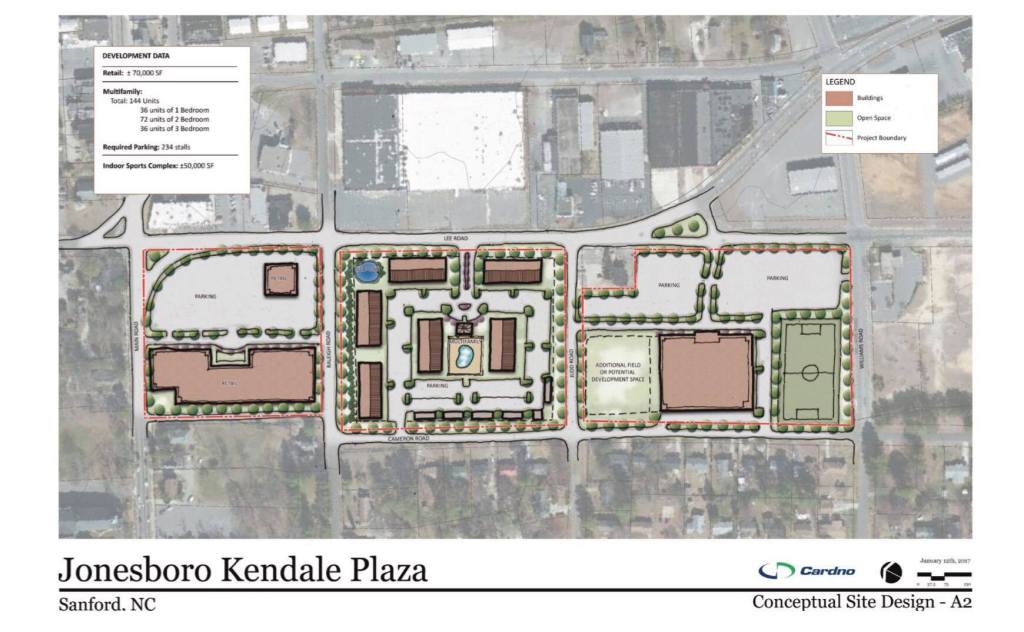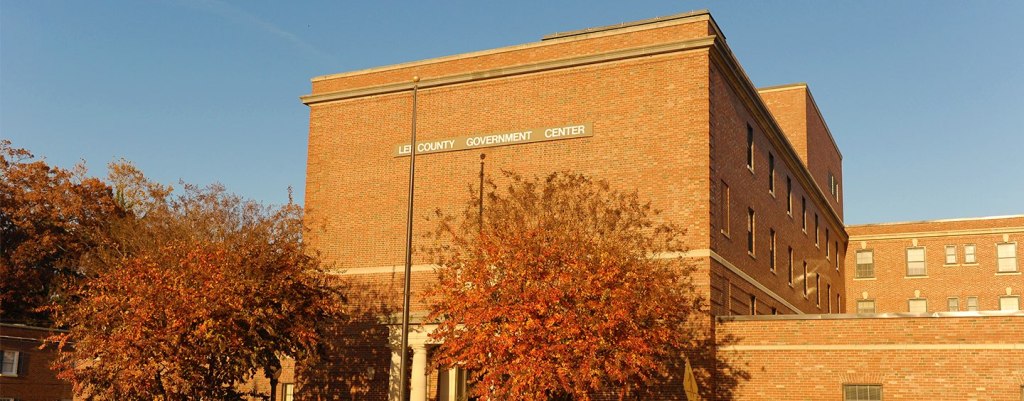(This is the final in a three part series examining the history, present and possible future of what is today one of Sanford’s most blighted commercial properties. Read part one here, and part two here.)
The prescription offered by a 2016 report about redeveloping and revitalization downtown Jonesboro is clear: the Kendale Plaza shopping center will need to undergo a drastic change in order for it – or the community surrounding it – to thrive again.
But despite that prognosis – and the reality that the blighted property is detrimental to the surrounding community – Kendale remains profitable, generating nearly $300,000 in profit each year. That’s per a listing which shows Kendale Plaza is on the market for $3.85 million.
That doesn’t mean finding a buyer willing to invest in the property rather than continue to proverbially squeeze blood from the stone would be impossible, but it does place a stumbling block firmly in the road to progress. So what can be done to move that block?

A partial answer to that question can be found in the sale offering, which we highlighted in the first part of this series: “The City of Sanford is ready and willing to work with Kendale Plaza for redevelopment efforts.”
Here’s what to take away from that sentence: While Kendale Plaza faces many private sector problems, at least one of the keys to solving them might be in the public sector. Sanford Mayor Chet Mann is a firm believer that Kendale can be saved, and in the city’s ability to help that happen.
“Anything that was tremendously successful in the past can be tremendously successful again, but there has to be a vision for repurposing so it can be healthy and thriving again,” he said. “It would be very hard for it to be successful being the same thing it’s always been. The way people see it today is hopefully not going to be the same way they see it in 10 or 20 years.”
City involvement could take a lot of forms, and Mann said discussions are likely to begin soon on how the city can drive a potential buyer toward the repurposing he discussed.
One tool to leverage a buyer toward redevelopment – or at the very least, away from stagnation – is something called called “economic redevelopment zones.” They are often are implemented in areas with properties considered troublesome, and while Mann described the city’s relationship with Kendale’s owners as cooperative, he said such a tool could make the shopping center less attractive to a buyer who simply wants to take profit from the shopping center without making any investments.
“The legislature has made it possible for us to basically draw a line around any area and that area can be more highly enforced for code enforcement,” he said.
That kind of “zone” isn’t necessarily a magic bullet – City Manager Hal Hegwer said “enforcement certainly isn’t a redevelopment tool, it’s more of a management tool” – but is an example of the myriad possibilities for a city’s involvement in repurposing a property like Kendale Plaze. Another possibility is to offer developers some kind of incentive to invest in a large scale rehabilitation effort.
“There are a bunch of guys out there who rehab these old centers. The city could afford to offer some incentives to someone who wants to take a property that’s on the tax books for $2 or $3 million and make it worth $12 or $15 million,” said Bob Joyce, Lee County’s economic development director.
Joyce listed waiving charges for debris removal, helping with asbestos removal, and reducing parking lot requirements as just some of the ways city government could help produce a desirable result at the blighted property.

City incentives for this type of rehabilitation wouldn’t even be unprecedented – we reported in in June that the owner of La Dolce Vita in downtown Sanford had entered into an agreement with the city over the so-called “federal building” which required her to commit $300,000 in renovations to the property and provide a certain number of new jobs in exchange for a lower purchase price on the building, and the Sanford Herald reported this week that the city had matched a similar state grant at the property (subscription required). Joyce said that smaller cities like Sanford looking at this type of economic development agreement is part of a pattern.
“Small cities are figuring out that what has worked in places like Raleigh can work for us too,” he said, citing Raleigh’s development of the Red Hat Ampitheater and the surrounding region as an example of a city outlining the conditions under which blighted properties can be repurposed. “The city gets rid of blight, and it puts money back into the tax base.”
Indeed, the North Carolina League of Municipalities has an entire website dedicated to celebrating the kind of public investments that result in public benefits like, well, the repurposing of old properties, for example. HereWeGrowNC.org is a project of the League that shares stories of “investments made by municipalities (that) have helped fuel growth.”
“We’re charting amazing examples from all over the state of how cities and towns are directly investing or partnering with the private sector for revitalization, to spur new business and jobs, and improve quality of life,” said League Advocacy Communication Associate Ben Brown. “The public sees the rippling benefits and feels connected to what their local government is doing. With that said, it goes well beyond the local economy. These individual examples add up for the state on the whole.”
Mann also said the city is examining the possibility of recruiting the North Carolina School of Government’s Development Finance Initiative (DFI) – which “partners with local governments to attract private investment for transformative projects by providing specialized finance and development expertise,” according to its website – to look at the property and make recommendations.
“They consult on revitalization projects,” Mann said. “They will do a study and make recommendations, but they also will go out and find partners for the city to do this kind of work.
It could even go a step further. Mann said he’s explored on a very provisional basis the possibility – assuming a good price could be negotiated – of the city buying the property outright, partnering with a developer to construct multifamily housing on the bottom block, and redeveloping the remaining two blocks under a village retail concept before selling the property back to a private buyer. It would be a bold step, but one he said he believes could drastically alter the character of the neighborhood for the better.
Again, such a consideration wouldn’t be unprecedented, at least in general terms. In Part 2 of this series, we linked to a Sanford Herald story in which City Councilman Charles Taylor had lobbied for the city to purchase a bank building across Lee Avenue from Kendale Plaza. That purchase – which didn’t happen; the building is set to open shop soon as a pediatric medical practice – would have been for the purpose of housing city government functions, and yeah, the comparison breaks down after a point. But the point isn’t that every opportunity represents an apples to apples comparison, it’s that cities are capable of engaging in projects of this type, on a number of levels.
“I just feel like a good city council can’t afford to ignore Kendale,” Mann said. “We think and believe it can be vibrant again.”
What’s clear is that Kendale Plaza – long a source of frustration for civic leaders and residents alike – is at a crossroads, and that the city has an opportunity to guide it toward progress.
Whatever happens, it’s likely to start happening fast. So keep paying attention.













